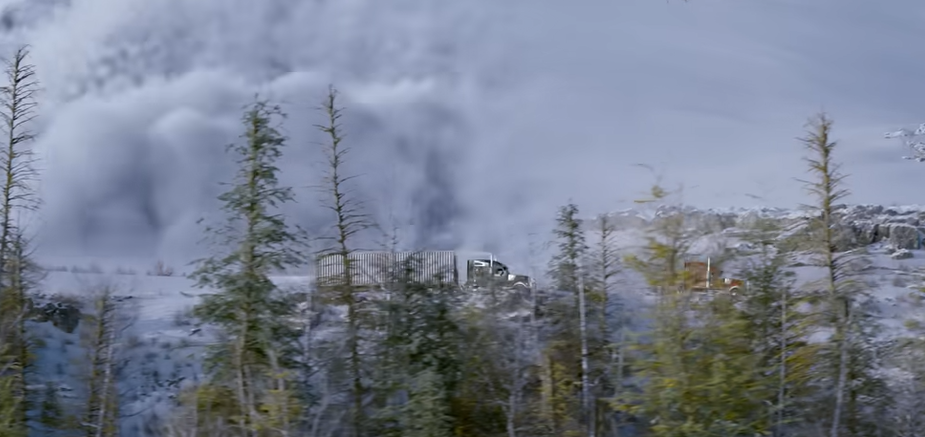Modern film frequently combines reality with painstakingly created illusions, as demonstrated by the controversy surrounding whether Ice Road Vengeance was truly shot in Nepal. Although most of the filming took place in Australia, the entire film is set in Nepal, transporting viewers from the chaos of Kathmandu’s streets to the Everest slopes. A tiny gold-rush town in Victoria called Walhalla was meticulously transformed to resemble a Himalayan community, complete with steep backdrops, prayer flags, and stone walls that remarkably resemble real Nepali villages.
From a production perspective, this method was incredibly successful. The seventy-year-old Liam Neeson is still a very effective action star, but he finds it difficult to handle the demands of filming at high altitudes. Using virtual production technology at Docklands Studios in Melbourne, filmmakers were able to recreate dangerous tunnels and rocky Himalayan passes with a remarkably high degree of detail. Real landscapes were streamed by large LED walls, and stunt coordinators created scenes that couldn’t be filmed at actual elevations.
However, the filmmakers did not completely abandon authenticity. In Nepal, second-unit crews documented the living history of Patan Durbar Square, rickshaws making their way past shrines, and busy Kathmandu alleys. This UNESCO heritage site gave the narrative a remarkably enduring presence on screen, firmly establishing it in cultural reality. Despite its reliance on cinematic tricks, the film’s texture and credibility were significantly enhanced by these authentic shots that were interwoven into Australian sets.
Ice Road: Vengeance – Film Data and Key Information
| Attribute | Details |
|---|---|
| Title | Ice Road: Vengeance |
| Release Year | 2025 |
| Director | Jonathan Hensleigh |
| Lead Actor | Liam Neeson |
| Co-Stars | Fan Bingbing, Bernard Curry, Grace O’Sullivan |
| Setting | Nepal (Kathmandu, Everest Base Camp, villages) |
| Main Filming Locations | Walhalla (Victoria, Australia), Docklands Studios Melbourne, some shots in Nepal & India |
| Genre | Action / Thriller |
| Distribution | Netflix and Amazon Prime Video |
| Reference Website | IMDb – Ice Road: Vengeance |

From travel documentaries to Doctor Strange, Nepalese heritage sites have previously starred in international blockbusters. Their inclusion here carries on the tradition of local culture influencing international film. Such views can be especially advantageous for Nepal, promoting travel and igniting interest in the nation’s history and architecture. Similar to how New Zealand after The Lord of the Rings or Dubrovnik after Game of Thrones, Nepal’s presence, even if it is only partial, expands its identity to audiences around the world.
However, there have been differing opinions from critics. Some praised the immersive atmosphere and pointed out how well Walhalla mirrored the foothills of the Himalayas, while others thought the visual effects were startling. A bus that was shown toppling over a cliff was mocked for defying physics in one scene, demonstrating how computer-generated imagery can occasionally drastically diminish perception. However, this contrast highlights a greater cinematic challenge: balancing the growing demand for authenticity from audiences with affordable studio work.
Ice Road Vengeance for Liam Neeson follows a trend set by Taken, in which his rugged resolve serves as the foundation for unlikely stories. His icy performances in Cold Pursuit and The Grey are reminiscent to fans, but this movie goes farther by setting him up against mercenaries in Nepalese settings that have been recreated elsewhere. Although some of the fight scenes reflect his advanced age, his presence is incredibly dependable, making what could have been a forgettable thriller at least watchable.
The story illustrates how filmmaking no longer respects boundaries from a cultural perspective. This is cinema at its most hybrid: an American production with a Nepali setting, shot in Australia, and streamed worldwide on Netflix and Amazon Prime. While creative teams pieced together bits of simulation and authenticity, producers made sure the business was financially viable through strategic alliances. As an approach, it is especially inventive, demonstrating how storytelling changes when actual mountains are inaccessible but still desired.
Audiences are still perceptive. They are sensitive to the difference between authentic and fake landscapes. While the scenes in Kathmandu seem vibrant and full of real textures, the digitally rendered cliffs frequently seem lifeless. Many fans have recently drawn comparisons to Taken 3 or other sequels where Neeson’s charisma overcame subpar editing. The paradox is that Hollywood chose to mimic a lot of Nepal’s landscapes, even though they are sufficiently dramatic to require minimal digital editing.
A significant social question is brought up by this: if the story is still engaging, does authenticity matter as much as illusion? Cultural settings should be more authentically portrayed, according to some, while others contend that filmmaking is about suspending disbelief. The solution in the case of Ice Road Vengeance appears to be striking a balance between providing enough real-life glimpses to highlight Nepal and using enough studio magic to keep the production reasonable.

